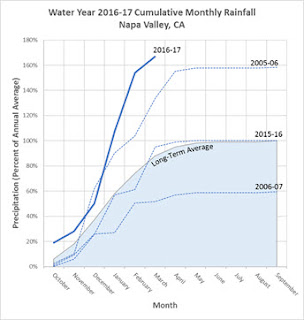Recent Napa Valley Vintages
It is important to remember that agriculture is an important aspect of the wine business. You cannot produce high quality wines with poor grapes. Challenges are everywhere for grape growers:
The last five years (2012-6) have been very good. In particular, 2013 and 2016 were nearly perfect years with ideal weather early in the growing season (Jan-Oct) that lead to early bud break (when green shoots first appear on the vines), early bloom and smooth and abundant fruit set (when flowers convert to berries), hearty canopy growth (the shoots with green leaves that protect the grapes from sun burn), rapid veraison (when grapes turn from green to red), a warm to hot end of the growing season with cool evenings, and lastly an early and uneventful harvest. Some critics call the 2013 vintage the greatest year ever for Napa/Sonoma wine production, and many vintners including us getting excited about the potential in the 2016 vintage developing in the barrel.
As good as 2013 and 2016 have been, the other vintages are no slouches. The consistency of 2012, 2014, and 2015 are impressive. In fact, 2015 might be as good as 2013 and 2016 except that yields were low. Many growers reported yields down by 20-50% and in some cases Pinot Noir vineyards in the Russian River area lost their entire crop. The California Department of Agriculture reported that the 2015 harvest in Napa County declined from 173,770 tons in 2014 to 123,319 tons (-29%). The average price per ton for grapes increased 6% due to the limited supply.
Most losses were traced to shatter when berries and clusters do not develop during blooming and fruit set. Several problems can cause shatter including rain shortly after flowers bloom knocking them off the vine, because the flowers are not pollinated, or due to extreme temperatures either hot or cold. Luckily, Greyscale Wines did not lose much yield in 2016 due to the vineyards from which we source fruit and the excellent work by the growers. Jean & I have tasted the wine in the barrel several times and are quite pleased with how it is developing.
- Warm weather with adequate rain are essential. Rain early in the season followed by sustained warm temperatures is optimal for producing outstanding grapes at harvest.
- Good vineyard practices are essential to reduce pests and diseases [Wine Science & Applications].
- Air pollutants such as ozone, sulfur dioxide, and wildfire smoke can alter the aroma, taste, and healthiness of harvested grapes.
- Costs continue to increase over time due to the cost of land, labor, and materials.
- Natural disasters like the South Napa earthquake in Aug 2014.
The last five years (2012-6) have been very good. In particular, 2013 and 2016 were nearly perfect years with ideal weather early in the growing season (Jan-Oct) that lead to early bud break (when green shoots first appear on the vines), early bloom and smooth and abundant fruit set (when flowers convert to berries), hearty canopy growth (the shoots with green leaves that protect the grapes from sun burn), rapid veraison (when grapes turn from green to red), a warm to hot end of the growing season with cool evenings, and lastly an early and uneventful harvest. Some critics call the 2013 vintage the greatest year ever for Napa/Sonoma wine production, and many vintners including us getting excited about the potential in the 2016 vintage developing in the barrel.
As good as 2013 and 2016 have been, the other vintages are no slouches. The consistency of 2012, 2014, and 2015 are impressive. In fact, 2015 might be as good as 2013 and 2016 except that yields were low. Many growers reported yields down by 20-50% and in some cases Pinot Noir vineyards in the Russian River area lost their entire crop. The California Department of Agriculture reported that the 2015 harvest in Napa County declined from 173,770 tons in 2014 to 123,319 tons (-29%). The average price per ton for grapes increased 6% due to the limited supply.
Most losses were traced to shatter when berries and clusters do not develop during blooming and fruit set. Several problems can cause shatter including rain shortly after flowers bloom knocking them off the vine, because the flowers are not pollinated, or due to extreme temperatures either hot or cold. Luckily, Greyscale Wines did not lose much yield in 2016 due to the vineyards from which we source fruit and the excellent work by the growers. Jean & I have tasted the wine in the barrel several times and are quite pleased with how it is developing.

Comments
Post a Comment